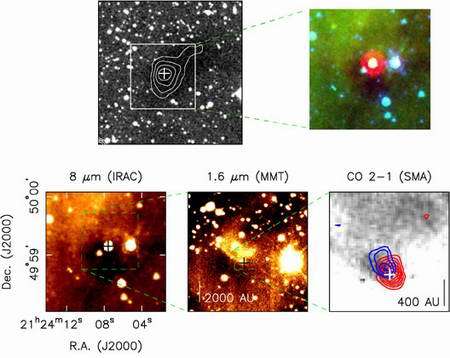Astronomers Decipher Nature of Mysterious Object
In an exercise that demonstrates the power of a multiwavelength investigation using diverse facilities, astronomers at the Harvard-Smithsonian Center for Astrophysics (CfA) have deciphered the true nature of a mysterious object hiding inside a dark cosmic cloud. They found that the cloud, once thought to be featureless, contains a baby star, or possibly a failed star known as a "brown dwarf," that is still forming within its dusty cocoon.
Observations indicate that the mystery object has a mass about 25 times that of Jupiter, which would place it squarely in the realm of brown dwarfs. However, its mass may eventually grow large enough to qualify it as a small star. The object also is cool and faint, shining with less than 1/20 the sun's luminosity.
"This object is the runt of the star formation family," said CfA astronomer Tyler Bourke.
Establishing the true nature of the object required the unique capabilities of the Submillimeter Array (SMA) in Hawaii. "The SMA spotted what no single-dish telescope could see," said Bourke.
Using the SMA, scientists detected a weak outflow of material predicted by star formation theories. That outflow-10 times smaller in mass than any seen before-confirmed both the low-mass nature of the object and its association with the surrounding dark cloud. "The sensitivity and resolution of the Submillimeter Array with its multiple antennas were crucial in detecting the outflow," said Bourke.
The puzzling object was discovered using a Smithsonian-developed infrared camera on board NASA's Spitzer Space Telescope. Spitzer studied the dusty cosmic cloud named L1014 as part of the Cores to Disks Legacy program. A core is the densest region of a cloud, massive enough to make a star like the sun.
L1014, located about 600 light-years away in the constellation Cygnus the Swan, initially was classified as a "starless core" because it showed no evidence for star formation. Astronomers were surprised when Spitzer images revealed a faint infrared light source that appeared to be within the core.
Additional data were needed to confirm that the faint object was directly associated with the dark core, rather than being a chance superposition of a more distant, more mundane background object.
Near-infrared observations by the MMT Observatory in Arizona revealed a scattered light nebula surrounding the faint central object in L1014. "Light from the object is bouncing off surrounding dust and toward us," said CfA astronomer Tracy Huard, who took the MMT images. "Reflection nebulosity like that is a fingerprint of an embedded object."

Image: Three Smithsonian observatories joined forces to decipher the nature of one mystery object. The dark cosmic cloud dubbed L1014 was thought to be a "starless core," but infrared and submillimeter data revealed that it contains a low-mass star or brown dwarf that is still forming.
At top left is the optical image of L1014, with contours of 1.2 mm dust emission, and the field-of-view of the Spitzer images indicated by the box. The position of young brown dwarf or protostar (dubbed L1014-IRS) is indicated. At top right is a 3-color image using the Spitzer data, color-coded by wavelength. At bottom left is the 8-micron-only image, at bottom middle is a near-infrared image from the MMT revealing a scattered light nebula typically seen around young stellar objects, thought to be due to a cavity evacuated by an outflow. At bottom right is the confirmation that L1014-IRS drives a bipolar outflow, seen with the Submillimeter Array. The outflow velocities associate the infrared source with starless core L1014 at a distance of 200 parsecs, thus confirming its low luminosity and mass. Credit: Tyler Bourke & Tracy Huard (CfA)
The apparent size of the nebulosity indicated that the light source likely was located within L1014 and not in a more distant cloud. MMT data also gave investigators the orientation in space, or tilt, of the object within L1014. Astronomers then turned to the SMA for final confirmation.
"The Spitzer observations gave us hints to the nature of the object inside L1014. The MMT strengthened the association between the infrared source and the starless core. The Submillimeter Array clinched the case and revealed this object's true identity," said Bourke.
By studying faint, young objects like the one still forming within L1014, astronomers hope to learn more about the early stages of star formation.
"The most elusive part of star formation is the moment of birth," said CfA astronomer Phil Myers. "In order to answer how it happens, you need examples of very young systems. This system is only about 10,000 to 100,000 years old - a baby as far as stars or brown dwarfs go."
The combined capabilities of Spitzer, the SMA and the MMT were essential for finding and examining this object. Those facilities undoubtedly will prove useful in studying similar very dim, very young objects-objects so young that they are still growing. "They're so young and faint that we can't tell how much mass they will accumulate," Myers added. "There's no prenatal test for these objects. We're not sure exactly what we'll get in the end!"
A paper by Tyler L. Bourke et al. covering the SMA observations will be published in an upcoming issue of The Astrophysical Journal Letters and is available online at arxiv.org/abs/astro-ph/0509865
A second paper by Tracy L. Huard et al. covering the MMT observations will be published in The Astrophysical Journal and is available online at arxiv.org/abs/astro-ph/0509302
Source: Harvard-Smithsonian Center for Astrophysics
















